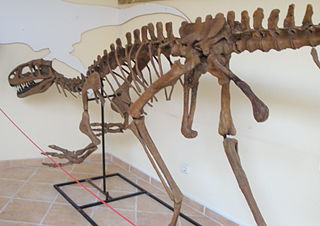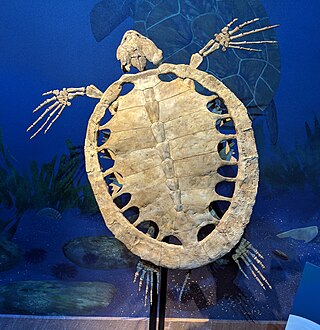
Machimosaurus is an extinct genus of machimosaurid crocodyliform from the Late Jurassic and Early Cretaceous. The type species, Machimosaurus hugii, was found in Switzerland. Other fossils have been found in England, France, Germany, Portugal, Switzerland and Tunisia. Machimosaurus rex is the largest named teleosauroid and thalattosuchian, with an estimated length of up to 7.15 m (23.5 ft). Machimosaurus is the largest known crocodyliform of the Jurassic.

Lourinhanosaurus was a genus of carnivorous theropod dinosaur that lived during the Late Jurassic Period (Kimmeridgian/Tithonian) in Portugal. It is one of many large predators discovered at the Lourinhã Formation and probably competed with coeval Torvosaurus gurneyi, Allosaurus europaeus, and Ceratosaurus.

Lampetra is a genus of lampreys in the family Petromyzontidae.

Euclastes is an extinct genus of sea turtles that survived the Cretaceous–Paleogene mass extinction. The genus was first named by Edward Drinker Cope in 1867, and contains three species. E. hutchisoni, was named in 2003 but has since been reassigned to the genus Pacifichelys, while E. coahuilaensis named in 2009 was reassigned as Mexichelys coahuilaensis in 2010.

Harpalyce is a genus of flowering plants in the family Fabaceae. It belongs to the subfamily Faboideae. It includes 35 species of shrubs and small trees native to the tropical Americas. Their distribution is disjunct, ranging from Mexico to Nicaragua, Cuba, and northern to southeastern Brazil and Bolivia. Typical habitats include seasonally-dry tropical forest, warm-temperate humid forest, woodland, bushland and thicket, shrubland, and grassland. Most species are evergreen and flower during the dry season.
Chaudoirella is a genus in the ground beetle family Carabidae. This genus has a single species, Chaudoirella reichardti.
Carbonellia is a genus in the ground beetle family Carabidae. There are at least three described species in Carbonellia, found in South America.
Negrea is a genus of beetles in the family Carabidae, containing the following species:
Cylindropectus is a genus in the ground beetle family Carabidae. There are at least two described species in Cylindropectus, found in Africa.

Eucamptognathus is a genus of beetles in the family Carabidae, containing the following species:
Andinorites is a genus of beetles in the family Carabidae, containing the following species:
Columbitrechus is a genus in the ground beetle family Carabidae. This genus has a single species, Columbitrechus subsulcatus. It is found in Colombia.
Luyatrechus cuelapensis is a species of beetle in the family Carabidae, the only species in the genus Luyatrechus. There are currently 0 confirmed observations of Luyatrechus.
Orotrechus is a genus of troglobitic beetles in the family Carabidae, containing the following species:
Pseudotrechisibus sphaericus is a species of beetle in the family Carabidae, the only species in the genus Pseudotrechisibus.
Trechisibus is a genus of in the beetle family Carabidae. There are more than 150 described species in Trechisibus.

Alcovasaurus, alternatively known as Miragaia longispinus, is a genus of herbivorous stegosaurian dinosaur that lived in the Late Jurassic. It was found in the Morrison Formation of Natrona County, Wyoming, United States. The type species is Stegosaurus longispinus, later given the genus Alcovasaurus.

Cardiocorax is an extinct genus of elasmosaurid known from the Late Cretaceous Mocuio Formation of Namibe Province, southern Angola. It contains a single species, Cardiocorax mukulu.

Trechini is a large tribe of ground beetles in the family Carabidae. There are more than 270 genera and over 2,400 described species in Trechini, found throughout the world.

Issi is a plateosaurid dinosaur described in 2021 from the Late Triassic Fleming Fjord Formation of Greenland. It contains one species, Issi saaneq; the full binomial name means "cold bone".









